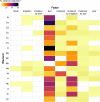Rootstock effects on scion phenotypes in a 'Chambourcin' experimental vineyard
- PMID: 31069086
- PMCID: PMC6491602
- DOI: 10.1038/s41438-019-0146-2
Rootstock effects on scion phenotypes in a 'Chambourcin' experimental vineyard
Abstract
Understanding how root systems modulate shoot system phenotypes is a fundamental question in plant biology and will be useful in developing resilient agricultural crops. Grafting is a common horticultural practice that joins the roots (rootstock) of one plant to the shoot (scion) of another, providing an excellent method for investigating how these two organ systems affect each other. In this study, we used the French-American hybrid grapevine 'Chambourcin' (Vitis L.) as a model to explore the rootstock-scion relationship. We examined leaf shape, ion concentrations, and gene expression in 'Chambourcin' grown ungrafted as well as grafted to three different rootstocks ('SO4', '1103P' and '3309C') across 2 years and three different irrigation treatments. We found that a significant amount of the variation in leaf shape could be explained by the interaction between rootstock and irrigation. For ion concentrations, the primary source of variation identified was the position of a leaf in a shoot, although rootstock and rootstock by irrigation interaction also explained a significant amount of variation for most ions. Lastly, we found rootstock-specific patterns of gene expression in grafted plants when compared to ungrafted vines. Thus, our work reveals the subtle and complex effect of grafting on 'Chambourcin' leaf morphology, ionomics, and gene expression.
Keywords: Natural variation in plants; Plant sciences; Plant signalling.
Conflict of interest statement
Compliance with ethical standardsThe authors declare that they have no conflict of interest.
Figures






References
-
- Mudge, K., Janick, J., Scofield, S. & Goldschmidt, E. E. A History of Grafting. in Horticultural Reviews 437–493 (John Wiley & Sons, Inc., Hoboken, New Jersey, 2009).
-
- Ollat, N., Bordenave, L., Tandonnet, J. P., Boursiquot, J. M. & Marguerit, E. Grapevine rootstocks: origins and perspectives. Acta Hortic. 11–22 (2016).
-
- Fort K, Fraga J, Grossi D, Walker MA. Early measures of drought tolerance in four grape rootstocks. J. Am. Soc. Hortic. Sci. 2017;142:36–46. doi: 10.21273/JASHS03919-16. - DOI

